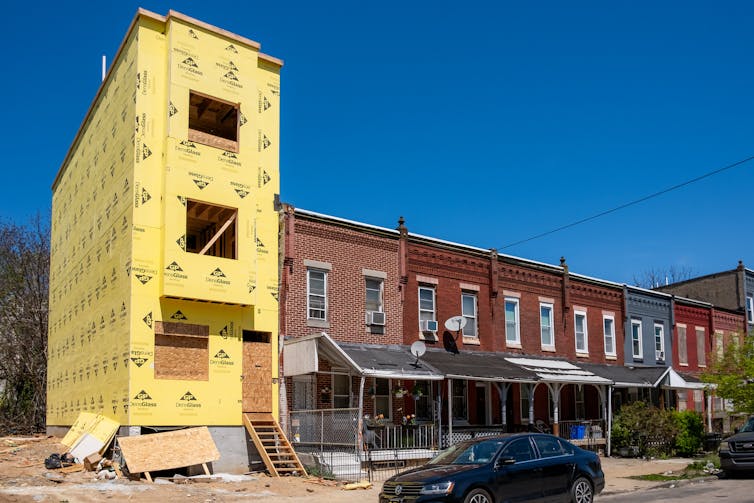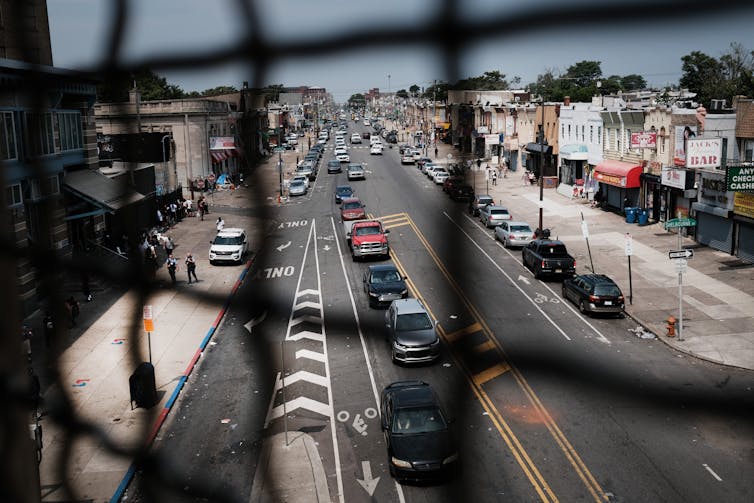In 2023, 410 people were murdered in Philadelphia – more than a quarter of them under age 25. In addition to the people who died, countless others lost loved ones and people they relied on.
As a social scientist who studies different forms of violence and how they affect a person’s health, I know that the violence young people in Philadelphia experience is about more than shootings, homicides and physical injuries. Social science recognizes many different types of violence beyond the physical – for example, poverty, racism and negative interactions with police.
Furthermore, violence can take a toll on one’s health even if the person is unaware of it. For example, I once interviewed a young man from West Philadelphia and tracked his heart rate. When a shooting occurred outside his living room window, his heart rate spiked suddenly from 51 beats per minute and hit 116. He had heard the gunshot, but it did not upset him. He felt he had been hardened to the violence happening in front of his door, and he was shocked to learn that his body had reacted so strongly.
To better understand the relationship between forms of violence and their impacts, I conducted an ethnographic study involving 12 young people ages 16 to 21 who lived in different Philadelphia neighborhoods where violence is prevalent. These included Kensington, the Northeast, Germantown, Cobbs Creek and Belmont. The study lasted from 2016 to 2018 and was recently published in the peer-reviewed Journal of Adolescent Research. The names used in this article are pseudonyms to protect the identities of the young people who contributed to my research.
I spent a month with each young person. I walked through their neighborhoods with them, interviewed them about their family histories and measured their heart rates as they went about their day. They wore wristband health monitors and carried a separate GPS tracker for four days. At the end of each day, I sat with them and reviewed their heart rate data and where they went.
I learned that where a young person lives, the societal messages they absorb and the different forms of violence they experience can deeply affect their physical and mental health.
‘No shade, no trees, no big parks’
The young people I worked with understood the lack of investments in their neighborhoods as signals that those in power did not care about them, their families or their communities. They talked about public school closures, the limited access to libraries and lack of trees or green space. Walking with me around her Cobbs Creek neighborhood, Desmond, 21, said, “Who would want to live here? There’s no shade, no trees, no big parks.”
They also saw how gentrification – the process of wealthier persons and investments displacing local businesses and residents – was changing their neighborhoods. Kalia, having lived her life in “little Puerto Rico,” as she called her Kensington neighborhood, told me how she felt about wealthier people moving in.
“Remember how I was saying that we’re loud, and we’re all like close to each other, we all just hang out and stuff? And they’re not like that. They’re quiet, and they have all their money, you know?” she said. “So I feel like they’re not only trying to change the neighborhood, they’re just trying to change the way people live.”

‘I can’t blame them, though’
Working with the five young Black men in the study, I learned how their day-to-day interactions with the police impacted their self-worth. They shared experiences of police slamming them against a wall, knocking food out of their hands, refusing to believe they didn’t have a criminal record or chasing them out of parks.
In sharing these interactions, it was clear that several of the young men had internalized false messages from society and culture that Black men commit more crimes and act more aggressively than white people. Kareem, from West Philadelphia, summed up his thoughts on it like this: “If you was a criminal, then they probably treat you in a certain way. But since almost every Black person be getting into almost everything, they think we all criminals. I can’t blame them, though.”
Future, from Southwest Philly, had a particularly tense interaction with police and came into an interview feeling, he said, “hyped up.” His heart rate had increased from 60 to 106 beats per minute when approached by the police, and then elevated to 130 BPM within 10 minutes. It remained elevated for 30 minutes.
While walking to our interview, Future told me, he had stopped to spend the last of his cash on a breakfast sandwich and a coffee. Shortly after, a police officer knocked the sandwich out of his hand, pushed him against a wall and handcuffed him. “They thought I had dope, weed and pills on me, and then I’m like, ‘I don’t got nothing,’” he said. They asked him for his ID, to which he countered, “Why you got me in cuffs?” Then they threatened to bring him into the station.
“Listen, I’m being obedient,” Future told the officers, explaining that he was on probation. After police “threw” him in the back of the car, he said, a neighbor began filming the incident and asked the police what they were doing. Future said the younger cop reached for his gun while his partner “tried to get me to rat on my ‘hood.”
The purpose of the police encounter, it seemed, was to gain information about the goings on in the neighborhood. The young men I talked with said they’d often had similar experiences.

'It’s a deep emotional ride’
Whether it was through experiencing police brutality, the child welfare system, homelessness or past trauma, each of the young people I worked with grappled with the impacts of interpersonal, structural and symbolic violence in different ways. Sometimes it was apparent in their mental health, manifesting in eating disorders, severe anxiety or bouts of depression.
Conner, a young Black man living in Belmont, experienced severe anxiety that at times kept him from leaving his house. His heart rate would spike on public transit, sometimes reaching 150 BPM, as he worried about neighborhood arguments spilling over onto the bus. He would go to the gym late at night to avoid fights, and he talked about the friends he had lost to gun violence. On how he felt about these losses, he said, “It’s a deep emotional ride, but I mean, the majority of us, people of color, we’re used to things like that happening.”
For others, their physical health suffered as well. One young woman, for instance, had witnessed severe violence in her home during her childhood and had been involved with the child welfare system both as a child and as a mother. She struggled with hypertension, severe headaches, obesity and anxiety. She lamented that getting care was just out of reach, particularly for her mental health. Every time she started to connect to a therapist, she said, either the center would close or the therapist would leave.
The research is clear that childhood trauma leads to higher rates of early morbidity and health ailments such as cardiovascular disorders. But it was striking to see these symptoms starting among people still in their teenage years.

Holistic interventions
Society typically tries to reduce violence by fixing individual behaviors – using metal detectors to curb weapons, for example, or creating mentoring programs for individuals deemed at-risk for violence.
I believe a more holistic approach would go further. Libraries, parks and community centers promote education, physical activity and social cohesion for children in high-poverty neighborhoods. Connecting people with jobs that pay a living wage helps them maintain a decent quality of life and increase their self-worth. Investing in quality mental health services in neighborhoods that lack them can provide young people with the professional support they need to process their environment and what is happening around them.
In short, recognizing that violence comes in many forms, and requires multiple levels of intervention, could make a world of difference.

